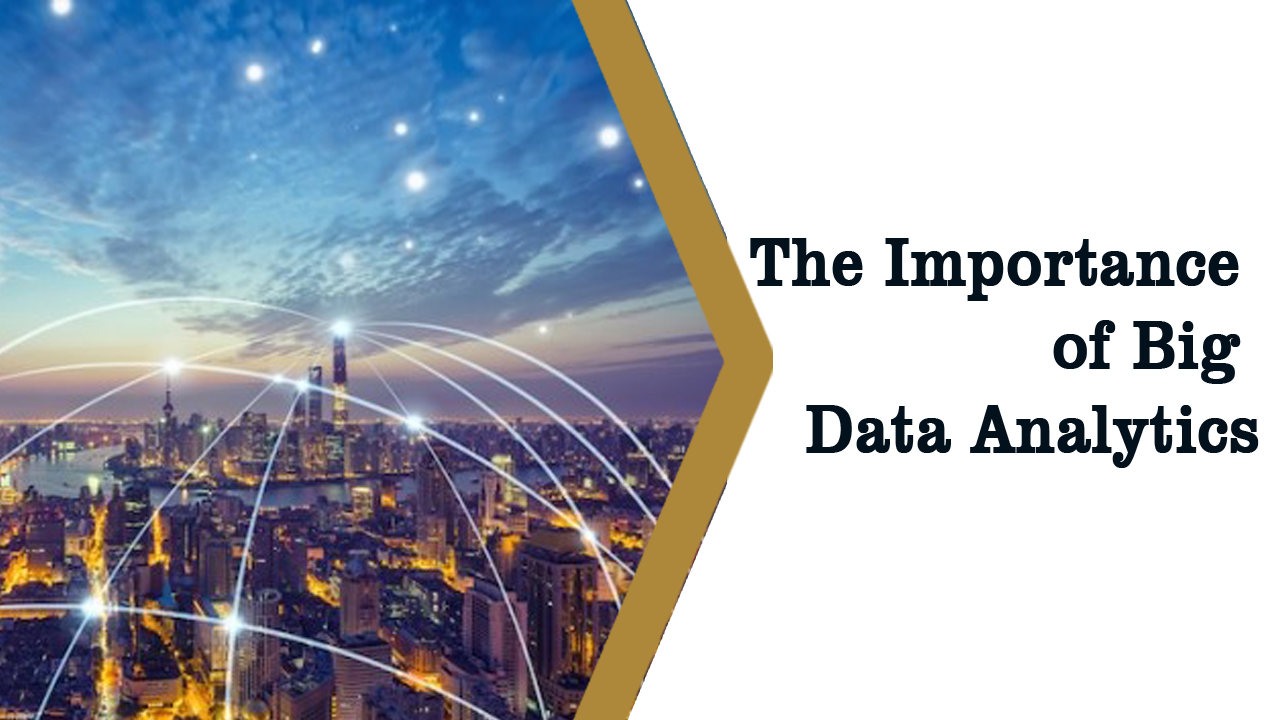Introduction Importance of Big Data Analytics
In today’s digital age, businesses and organizations are generating vast amounts of data. This data can come from various sources, including social media, customer transactions, and sensor networks. However, the challenge is how to turn this data into meaningful insights that can drive business decisions. This is where Big Data Analytics comes in. In this article, we will explore the importance of Big Data Analytics and how it can benefit organizations. 
What is Big Data Analytics?
Big Data Analytics is the process of analyzing large and complex data sets to uncover hidden patterns, correlations, and other insights. It involves using advanced technologies and techniques to process, store, and analyze data. Big Data Analytics can help organizations to make informed decisions, improve operations, and gain a competitive advantage.
The Importance of Big Data Analytics
The importance of Big Data Analytics cannot be overstated. Here are some of the reasons why it is crucial for organizations: 1. Making Informed Decisions: Big Data Analytics can help organizations make data-driven decisions. By analyzing data, organizations can gain insights into customer behavior, market trends, and other factors that can affect their business. 2.
Improving Operations: Big Data Analytics can help organizations optimize their operations. For example, it can help them identify bottlenecks in their supply chain, improve inventory management, and reduce costs. 3. Gaining a Competitive Advantage: Big Data Analytics can help organizations gain a competitive advantage. By analyzing data, organizations can identify new market opportunities, improve their products and services, and stay ahead of
heir competitors. 4. Personalizing Customer Experience: Big Data Analytics can help organizations personalize their customer experience. By analyzing customer data, organizations can understand their preferences, behaviors, and needs. This can help them tailor their products and services to meet the specific needs of their customers. 5. Improving Risk Management: Big Data Analytics can help organizations improve their risk management. By analyzing data, organizations can identify potential risks and take steps to mitigate them. This can help them avoid costly mistakes and reduce the impact of unexpected events.
Applications of Big Data Analytics
Big Data Analytics is being used in a wide range of applications across different industries. Here are some examples: 1. Healthcare: Big Data Analytics is being used in healthcare to develop personalized treatments and improve patient outcomes. By analyzing patient data, healthcare providers can identify the most effective treatments for individual patients. 2.
Finance: Big Data Analytics is being used in finance to detect fraud and optimize investment decisions. By analyzing financial data, organizations can identify patterns that indicate fraudulent activity and make better investment decisions. 3. Retail: Big Data Analytics is being used in retail to analyze customer behavior and optimize inventory management. By
analyzing customer data, retailers can understand their preferences, buying behavior, and needs. This can help them optimize their inventory, reduce waste, and improve customer satisfaction. 4. Manufacturing: Big Data Analytics is being used in manufacturing to optimize production processes and reduce downtime. By analyzing machine data, manufacturers can identify bottlenecks, predict failures, and improve maintenance schedules.
Challenges in Big Data Analytics
Despite the many benefits of Big Data Analytics, there are also challenges. Here are some of the challenges: 1. Data Quality: Big Data Analytics relies on high-quality data. However, data can be incomplete, inaccurate, or inconsistent. This can lead to erroneous insights and decisions. 2. Data Security and Privacy: With the increasing amount of data being generated,
there is a risk of data breaches and cyber attacks. Organizations need to take steps to ensure that their data is secure and that they comply with regulations such as GDPR and HIPAA. 3. Skilled Professionals: Big Data Analytics requires a diverse set of skills, including statistics, machine learning
The Importance of Big Data Analytics
In an era where data is often referred to as the new oil, big data analytics stands as a transformative force across various sectors. The ability to harness and analyze vast amounts of data is no longer a luxury but a necessity for organizations seeking to gain a competitive edge, drive innovation, and make informed decisions. This article delves into the importance of big data analytics, highlighting its impact on businesses, industries, and society at large.
1. Informed Decision-Making
Overview: One of the most significant benefits of big data analytics is its ability to provide actionable insights for decision-making. By analyzing large datasets, organizations can uncover trends, patterns, and correlations that inform strategic choices and operational improvements.
Key Points:
- Data-Driven Decisions: Organizations can move beyond intuition and gut feelings to base decisions on solid data analysis, leading to more accurate and reliable outcomes.
- Real-Time Insights: Big data analytics enables real-time monitoring and analysis, allowing businesses to respond quickly to emerging trends and changing conditions.
Example: Retailers use big data analytics to understand customer purchasing behaviors, enabling them to optimize inventory levels, personalize marketing strategies, and improve customer satisfaction.
2. Enhanced Customer Experience
Overview: Big data analytics plays a crucial role in enhancing the customer experience by providing deeper insights into customer preferences, behaviors, and needs.
Key Points:
- Personalization: By analyzing customer data, businesses can deliver personalized recommendations, targeted promotions, and tailored services that resonate with individual preferences.
- Customer Insights: Analytics help organizations understand customer feedback, identify pain points, and improve service delivery based on real-world data.
Example: Streaming services like Netflix use big data analytics to recommend content based on viewers’ past watching habits, leading to a more engaging and personalized user experience.
3. Operational Efficiency
Overview: Big data analytics helps organizations streamline operations, optimize processes, and reduce costs by identifying inefficiencies and areas for improvement.
Key Points:
- Process Optimization: Analyzing operational data can reveal inefficiencies, bottlenecks, and opportunities for process improvements, leading to more efficient workflows.
- Cost Reduction: By leveraging predictive analytics, organizations can forecast demand, manage resources more effectively, and minimize operational costs.
Example: Manufacturing companies use big data to monitor equipment performance, predict maintenance needs, and optimize production schedules, resulting in reduced downtime and operational costs.
4. Innovation and Competitive Advantage
Overview: Big data analytics drives innovation by uncovering new opportunities, facilitating the development of new products and services, and providing a competitive edge.
Key Points:
- Market Trends: Analyzing market data helps organizations identify emerging trends, customer needs, and competitive dynamics, enabling them to stay ahead of the curve.
- Product Development: Insights from big data can guide the creation of innovative products and services that meet evolving customer demands.
Example: Technology companies use big data to analyze user behavior and preferences, guiding the development of new features and improvements that enhance product offerings and maintain competitive advantage.
5. Risk Management and Fraud Detection
Overview: Big data analytics enhances risk management and fraud detection by identifying patterns and anomalies that may indicate potential risks or fraudulent activities.
Key Points:
- Risk Assessment: Analyzing data from various sources allows organizations to assess potential risks and implement strategies to mitigate them.
- Fraud Detection: Advanced analytics can detect unusual patterns and behaviors, helping to prevent fraud and secure sensitive information.
Example: Financial institutions use big data analytics to monitor transaction patterns and detect fraudulent activities in real-time, safeguarding against financial losses and ensuring compliance.
6. Healthcare Advancements
Overview: In healthcare, big data analytics has the potential to revolutionize patient care, improve treatment outcomes, and advance medical research.
Key Points:
- Personalized Treatment: Analyzing patient data helps tailor treatments to individual needs, improving effectiveness and reducing side effects.
- Predictive Analytics: Predictive models can forecast disease outbreaks, patient admissions, and potential health risks, enabling proactive interventions.
Example: Healthcare providers use big data to analyze patient records and genomic data, leading to more accurate diagnoses and personalized treatment plans.
7. Enhanced Decision-Making in Public Sector
Overview: Big data analytics benefits the public sector by improving decision-making, policy formulation, and service delivery.
Key Points:
- Policy Development: Data-driven insights support evidence-based policy decisions, enhancing the effectiveness of public programs and initiatives.
- Resource Allocation: Analyzing data helps allocate resources more efficiently, ensuring that public services are delivered where they are needed most.
Example: Governments use big data to analyze crime patterns, optimize emergency response strategies, and improve urban planning.
8. Environmental and Sustainability Initiatives
Overview: Big data analytics supports environmental and sustainability efforts by providing insights into resource usage, environmental impact, and sustainability practices.
Key Points:
- Resource Management: Analyzing environmental data helps monitor and manage natural resources, reducing waste and promoting sustainability.
- Impact Assessment: Big data helps assess the environmental impact of various activities and initiatives, guiding efforts to minimize negative effects.
Example: Energy companies use big data to optimize energy consumption, integrate renewable sources, and reduce carbon footprints.
9. Competitive Intelligence
Overview: Big data analytics provides organizations with valuable insights into competitors’ activities, market positioning, and industry trends.
Key Points:
- Market Analysis: Analyzing data on competitors’ strategies and market performance helps organizations identify opportunities and threats.
- Benchmarking: Big data enables organizations to benchmark their performance against industry standards and competitors.
Example: E-commerce companies use big data to monitor competitors’ pricing strategies, product offerings, and customer reviews, adjusting their strategies to maintain a competitive edge.
10. Improved Marketing Strategies
Overview: Big data analytics enhances marketing strategies by providing insights into customer behaviors, preferences, and campaign performance.
Key Points:
- Targeted Campaigns: Data-driven insights enable more precise targeting of marketing campaigns, increasing their effectiveness and ROI.
- Campaign Optimization: Analyzing campaign data helps refine marketing strategies, improve content, and adjust tactics based on performance metrics.
Example: Digital marketing agencies use big data analytics to track and analyze campaign performance, optimizing strategies and maximizing the impact of marketing efforts.
Conclusion
The importance of big data analytics cannot be overstated. By providing actionable insights, enhancing decision-making, driving innovation, and improving operational efficiency, big data analytics is a critical tool for organizations across industries. As data continues to grow in volume and complexity, the ability to harness and analyze it effectively will remain a key factor in achieving strategic success and fostering growth. Embracing big data analytics not only empowers organizations to navigate the complexities of the modern data landscape but also positions them to capitalize on emerging opportunities and drive transformative change.
